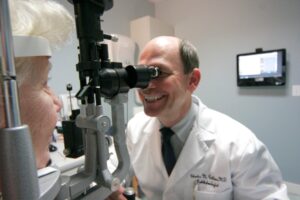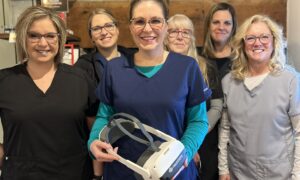
Dr. Collins examines a patient. He says that the principles of Lean Six Sigma help his office ensure a smooth patient flow while increasing efficiency.
Putting a system in place to skyrocket efficiency & improve patient experience.
By Charles (Charley) Collins, MD
May 15, 2024
I am an ophthalmologist, but my practice is composed primarily of optometrists with an emphasis on our optical services.
I experimented a lot over the years with what works best to move patients efficiently and profitably through our office while preserving a great patient experience.
Here is the system we put in place that improved our patient flow and boosted our net revenue growth.
Choosing an Approach to Work Toward Greater Efficiency
We were introduced to the topic of Lean Six Sigma through our search for a patient flow tracking solution for our new office. The system we chose (Visual Clinic) was designed around the fundamentals of Lean Six Sigma. We started using the system about October 2011 (a little over 12 years ago).
Editor’s note: There are many consultancies you can work with to improve efficiencies in your office, including Eyes on Eyecare, Williams Group and iCare Advisors, among many other options.
I believe that patient flow is absolutely critical to success. When patients are seen on time and treated efficiently, they feel valued and respected, resulting in a pleasant patient experience.
We were looking for efficiency when we moved to a new location. We were a thriving small practice beginning with electronic health records at that point. I wanted to implement patient flow communication mechanisms, and the steps we took far exceeded my expectations in what completing those steps delivered to our practice in improvements.
Focusing on “Visual Management”
Visual management is the first pillar of Lean Six Sigma. In an eyecare practice, the term “visual management” means creating real-time awareness for all staff on patient progress and resource availability. Essentially, we needed an easy way for managers or technicians to quickly realize when there are “stops” in our flow and when resources need to be relocated.
Other Articles to Explore
For doctors, visual management tells us quickly which room to go to next, how long patients have been waiting, how many are in the queue, and when we’re on break in the lunchroom or grabbing a snack, it helps us realize where we are needed next without having to stop and ask someone. It lets the front desk or anyone else in the clinic know where the clinicians or technicians are at any given time. Really, there’s no place for anyone to “hide,” but I’m sure that’s not a problem in any other practice. LOL!
For new techs, visual management tells us how long they have been with a patient, and when we need to go in and “bail them out.”
Specific Actions We Took to Implement Lean Six Sigma
The Key Lean Six Sigma methods we used were:
- Process Mapping: Writing down each care step a patient goes through.
- Work Step Time Balance: Getting the front desk, technicians and doctors working together at the same pace.
- Standard Work. Pursuing “efficiency through consistency.” Establishing agreed-to standards on how each work step should be accomplished. Having a written “Go By” for all tasks in our office.
- Zero Defects: Teamwork in identifying the root causes of errors or omissions in our daily work.
- Plan Do Check Act (PDCA): PDCA is a simple and universal method for managing improvement activities. PDCA can be thought of as a series of small changes (experiments) that the team conducts. If the change is successful, as determined by the data, it is adopted. If not successful, we start the loop again.
Lean Six Sigma Won’t Work Without an Empowered Staff
The biggest factor in our success was training and empowering our staff to improve their own work methods and contribute in the broader effort to elevate the patient experience.
This meant we had to schedule team meeting time for training and problem solving. This is not an easy task and takes a commitment on the part of the senior management to enable it to happen. The return on investment, however, is immeasurable.
How Much Did the Investment in Consulting & Transition to Lean Six Sigma Cost?
The costs could be broken down into two categories. First is the investment in training and empowering your staff. For us, this represented the labor costs for paying staff during the team meeting times and the training fee for an outside consultant who conducted the training. The total cost for our team meetings, which occurred twice per month, over the period of four months was less than $5,000.
Visual Clinic needs its own screens and data entry devices. Otherwise, we required no initial upgrades to our computer system. Five years ago, when we upgraded our Compulink EHR to the newest version, it led to about a $1,000 fee for an HL7 interface.
What Was ROI in Patient Experience?
We have impressed so many patients with our prompt service that they are sending their families and friends. Patients regularly comment, “Wow, I wish other doctors’ offices worked as well as yours, you are always on time!” We have need for more screening space and more exam lanes.
What Was ROI in Dollars & Cents?
Each year after implementing Lean Six Sigma principles, we saw improvement in our profitability.
Year 1
* $9,000 incremental expense
$110,000 incremental net profit
> 10 X return on investment
Years 2 through 10
* < 1.0% of practice revenue invested back into the practice for LSS team process improvement
* 6.5% compounded growth rate in net revenue over year two through 10.
Primed for Continued Growth
As of March 2024, we are achieving continued patient satisfaction and growth, and just had to add another optometrist to keep up with our increased patient volume.
We are now efficient enough to continue growing without our staff becoming overwhelmed or our patient experience suffering.
 Charles (Charley) Collins, MD, is the founding ophthalmologist and owner of Eye Care for Rhode Island in Middletown, R.I. To contact him: ccollinsmd@eyecareforri.com
Charles (Charley) Collins, MD, is the founding ophthalmologist and owner of Eye Care for Rhode Island in Middletown, R.I. To contact him: ccollinsmd@eyecareforri.com

























